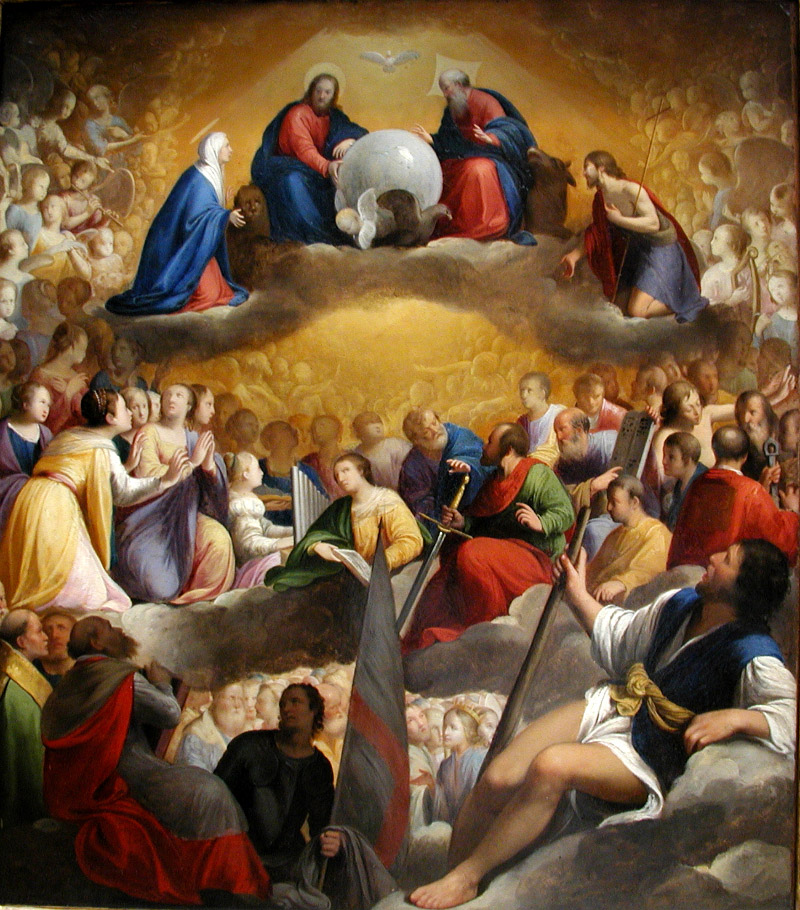Carlo Saraceni, Paradise

Late 16th century
Oil on copper
Metropolitan Museum of Art, 1971.93
In the center of the painting Saraceni places Saints Cecilia, Peter, and Paul. For Cecilia, he borrows a traditional narrative type in which, unmoved by the music at her nuptials, the saint looks up longingly to the music of Heaven (example). Here we see her ignoring the organ being played beside her as she gazes up with longing. A literalist might ask why she would be looking up to Heaven when she is already there, but it seems the artist is making a point about that moment during the nuptials. Moments when the earthly recedes and the saint is in touch with the divine are what Eliot called "the point of intersection of the timeless with time" – real Heaven in communion with real earth.1 In such a moment, one is in Heaven.
Similarly, one finds Peter and Paul engaged in the discussion that consumed the first generation of Christians, the relation of the gospel to the Law as given to Moses, who stands behind them with his tablets.2 Again, a literalist could object that in Heaven such matters would be settled, and disputation absent. But placing this debate in the very center of Heaven makes a vital point about the deliberations by which Truth is revealed to the Church. Such conversations are not simply human negotiations in historical time but moments of intersection when the earthly and heavenly environments are one.
In the composition Paul's sword lies along a line parallel to the tablets behind him and to the staff that St. Christopher holds in the foreground, emphasizing the multifariousness of the way to Heaven, which is also manifested in the teeming variety of the saints portrayed. Along the lower edge, for example, we have four theologians, one soldier, and one freak.3
To the right of St. George's banner is the scene from St. Catherine of Alexandria's passion in which she defends the faith to pagan philosophers, who then convert and are martyred. (Compare her hand gesture to this earlier image of her discourse.) Again, it makes no literal sense to have Catherine preaching in Heaven, but the speech and conversion constitute another moment in which human beings find themselves in the divine.
At the top of the painting we see the Father, Son and Holy Spirit (the dove between and above the two male figures), surrounded by the symbols of the four evangelists. To their left and right the Virgin and St. John the Baptist kneel in supplication as in Deësis images. To the left and right of this grouping are the angels of the heavenly choir (note the flute on the left and the harp on the right).
View this image in full resolution
Detail: The Trinity
Detail: SS. Cecilia, Peter, Paul, Moses
Detail: St. Christopher
Read more about Heaven
Photographed at the Metropolitan by Claire Stracke, shared under Attribution-NonCommercial-ShareAlike license.
1 T. S. Eliot, "The Dry
Salvages," 201f.
2 See Acts 15.
3 The label in the museum identifies the four saints on the lower left as Pope Gregory I, Augustine, Jerome, and Ambrose. Next on the right is St. George with his red cross banner, and finally Christopher, a giant sometimes portrayed with a dog's head whose name before his conversion was reprobus, "the reject."